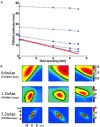Realistic spatial sampling for MEG beamformer images
- PMID: 15340934
- PMCID: PMC6872013
- DOI: 10.1002/hbm.20047
Realistic spatial sampling for MEG beamformer images
Abstract
The spatial resolution achievable using magnetoencephalography (MEG) beamformer techniques is inhomogeneous across the brain and is related directly to the amplitude of the underlying electrical sources [Barnes and Hillebrand, Hum Brain Mapp 2003;18:1-12; Gross et al., Proc Natl Acad Sci USA 2001;98:694-699; Van Veen et al., IEEE Trans Biomed Eng 1997;44:867-860; Vrba and Robinson, Proc 12th Int Conf Biomagn 2001]. We set out to examine what an adequate level of spatial sampling of the brain volume is in a realistic situation, and what implications these inhomogeneities have for region-of-interest analysis. As a basis for these calculations, we used a simple retinotopic mapping experiment where stimuli were 17-Hz reversing gratings presented in either left or right visual hemifield. Beamformer weights were calculated based on the covariance of the MEG data in a 0-80 Hz bandwidth. We then estimated volumetric full-width half-maximum (FWHM) maps at a range of sampling levels. We show that approximately 10% of the 1 mm cubic voxels in the occipital volume have a FWHM smoothness of <5 mm, and 80% <10 mm in three subjects. This was despite relatively low mean signal-to-noise ratios (SNR) values of 1.5. We demonstrate how visualization of these FWHM maps can be used to avoid some of the pitfalls implicit in beamformer region-of-interest analysis.
The spatial resolution achievable using magnetoencephalography (MEG) beamformer techniques is inhomogeneous across the brain and is related directly to the amplitude of the underlying electrical sources [Barnes and Hillebrand, Hum Brain Mapp 2003;18:1–12; Gross et al., Proc Natl Acad Sci USA 2001;98:694–699; Van Veen et al., IEEE Trans Biomed Eng 1997;44:867–860; Vrba and Robinson, Proc 12th Int Conf Biomagn 2001]. We set out to examine what an adequate level of spatial sampling of the brain volume is in a realistic situation, and what implications these inhomogeneities have for region‐of‐interest analysis. As a basis for these calculations, we used a simple retinotopic mapping experiment where stimuli were 17‐Hz reversing gratings presented in either left or right visual hemifield. Beamformer weights were calculated based on the covariance of the MEG data in a 0–80 Hz bandwidth. We then estimated volumetric full‐width half‐maximum (FWHM) maps at a range of sampling levels. We show that approximately 10% of the 1 mm cubic voxels in the occipital volume have a FWHM smoothness of <5 mm, and 80% <10 mm in three subjects. This was despite relatively low mean signal‐to‐noise ratios (SNR) values of 1.5. We demonstrate how visualization of these FWHM maps can be used to avoid some of the pitfalls implicit in beamformer region‐of‐interest analysis. Hum. Brain Mapping 23:120–127, 2004. © 2004 Wiley‐Liss, Inc.
Figures



Similar articles
-
Assessing interactions of linear and nonlinear neuronal sources using MEG beamformers: a proof of concept.Clin Neurophysiol. 2005 Jun;116(6):1300-13. doi: 10.1016/j.clinph.2005.01.014. Epub 2005 Mar 28. Clin Neurophysiol. 2005. PMID: 15978493
-
Statistical flattening of MEG beamformer images.Hum Brain Mapp. 2003 Jan;18(1):1-12. doi: 10.1002/hbm.10072. Hum Brain Mapp. 2003. PMID: 12454907 Free PMC article.
-
Source-space ICA for MEG source imaging.J Neural Eng. 2016 Feb;13(1):016005. doi: 10.1088/1741-2560/13/1/016005. Epub 2015 Dec 8. J Neural Eng. 2016. PMID: 26644284
-
Human cortical areas underlying the perception of optic flow: brain imaging studies.Int Rev Neurobiol. 2000;44:269-92. doi: 10.1016/s0074-7742(08)60746-1. Int Rev Neurobiol. 2000. PMID: 10605650 Review.
-
Magnetoencephalography: in search of neural processes for visual motion information.Prog Neurobiol. 2006 Dec;80(5):219-40. doi: 10.1016/j.pneurobio.2006.10.001. Epub 2006 Nov 20. Prog Neurobiol. 2006. PMID: 17113701 Review.
Cited by
-
Effect of Age in Auditory Go/No-Go Tasks: A Magnetoencephalographic Study.Brain Sci. 2020 Sep 25;10(10):667. doi: 10.3390/brainsci10100667. Brain Sci. 2020. PMID: 32992713 Free PMC article.
-
Consistency of magnetoencephalographic functional connectivity and network reconstruction using a template versus native MRI for co-registration.Hum Brain Mapp. 2018 Jan;39(1):104-119. doi: 10.1002/hbm.23827. Epub 2017 Oct 8. Hum Brain Mapp. 2018. PMID: 28990264 Free PMC article.
-
The Neural Dynamics of Novel Scene Imagery.J Neurosci. 2019 May 29;39(22):4375-4386. doi: 10.1523/JNEUROSCI.2497-18.2019. Epub 2019 Mar 22. J Neurosci. 2019. PMID: 30902867 Free PMC article.
-
Towards effective non-invasive brain-computer interfaces dedicated to gait rehabilitation systems.Brain Sci. 2013 Dec 31;4(1):1-48. doi: 10.3390/brainsci4010001. Brain Sci. 2013. PMID: 24961699 Free PMC article.
-
Ventromedial prefrontal cortex drives hippocampal theta oscillations induced by mismatch computations.Neuroimage. 2015 Oct 15;120:362-70. doi: 10.1016/j.neuroimage.2015.07.016. Epub 2015 Jul 14. Neuroimage. 2015. PMID: 26187453 Free PMC article.
References
-
- Adjamian P, Barnes GR, Hillebrand A, Holliday IE, Singh KD, Furlong PL, Harrington E, Barclay C.W, Route PJG (2004): Co‐registration of MEG with MRI using bite‐bar‐based fiducials and surface‐matching. Clin Neurophysiol 115: 691–698. - PubMed
-
- Cuffin BN, Cohen D (1979): Comparison of the magnetoencephalogram and electroencephalogram. Electroencephalogr Clin Neurophysiol 47: 132–146. - PubMed
-
- Fawcett IP, Barnes GR, Hillebrand A, Singh KD (2004): The temporal frequency tuning of human visual cortex investigated using synthetic aperture magnetometry. Neuroimage 21: 1542–1543. - PubMed
-
- Friston KJ, Holmes A, Poline JB, Price CJ, Frith CD (1995): Detecting activations in PET and fMRI: levels of inference and power. Neuroimage 4: 223–235. - PubMed
Publication types
MeSH terms
Grants and funding
LinkOut - more resources
Full Text Sources
Research Materials

